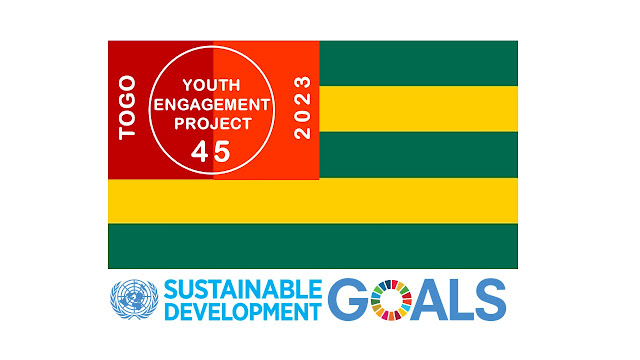TOGO YOUTH ENGAGEMENT 2023
TOGO is a West Africa country where Lome is the capital city on the southwest by seaside. From Germans to British and French invasion, Togo became independent in 1960 as agriculture depended economy, a coast country by lagoons, sandy beaches, lakes, plateau.
by Meryem Gurel
Here we introduce TOGO's macroeconomic conditions between 2000 and 2020.
Togo has 80% young population by 45 years old, and 50% school age population by 20years old.
Young women population by 45 years old need health, education and job. It composes of 78% of women population, and also Togo women population is declining. Women population remained same with 50% of total population and with a declining trend.
Young men population has been increasing and 79% of men population are young by the age of 45. There is a young male majority. Men population remained same with 49% of total population and with an increasing trend to 50% of total population.Income level between male and female differs that male income level is increasing while female income level is decreasing. GDP per capita increased from $500 to $650 between 2000-2020, wages differ from $500 to $3700. the average wage is around $800 (527,000 XOF).
Primary industries such as agriculture, fishing, forestry don't increase but trade and investments are increasing. Primary goods decreased from 30% to 18% according to World Bank Database below at graphics. However, Togo's agriculture contributes 40% of country GDP and 1.4 hectares of land are spread on the earth with plants implemented through national development plan between 2018-2022. On the contrary, weak lending opportunities, weak technical support, and poor use of fertilizers drive the fact of importance of agriculture covering 60% of population while it has rich soils and plateau as well as rocky earth. Togo lost its nourishment from 16.5 % in 2012 to 11.4 % in 2014, instead gained the green area accomplished with the national programme for agricultural investment and food security. Some programmes launched such as Agricultural Development Support Programme, West Africa Productivity Program, The Hydro-Agricultural Develop,ent of Mono River Valley, The Rice Production Program in Kara. Togo serves for national market and international market crops for export business such as cassava, yams, sorghum, coffee, cocoa, cotton, palm oil etc.
While trade and investments are increasing, trade business doesn't impact on income levels. Trade and inward foreign direct investments performed with an increasing trend then later a decline after 2020 due to Covid19. Although trade contribute to country annual GDP, it doesn't contribute to income level to increase. The West African countries invested in Togo for construction materials Nigeria and Burkina Faso. The main sectors attracted investments are cocao, coffee, cotton, infrastructure, phosphates and clay, and constructions while the main investors are France, Canada, and Brazil. Also, the port of Lome is an asset for international trade business as a free trade zone. Construction, electricity, property are some other plus assets expanded development in Togo.
Trends of primary and secondary goods show that agriculture and trade are decreasing after 2008 economic crisis and industrialization and carbon emissions are increasing.Economic growth trends has been demonstrating fluctuations and a decline while industrialization and investments are increasing. But capital formation has been fluctuating with declinings. Also, education, health and poverty, corruption, lack of infrastructure remain the same problems in Togo while safety and security need to be examined.
- TOGO, Togo | Location, History, Population, & Facts | Britannica
- Wages, Average Salary in Togo 2022 - The Complete Guide (salaryexplorer.com)
- Agriculture in Togo; An overview of agriculture in Togo: present and future... - Togo First
- Agriculture Products; Togo Agriculture, Information about Agriculture in Togo (nationsencyclopedia.com)
- Foreign Direct Investment in Togo; Togo Agriculture, Information about Agriculture in Togo (nationsencyclopedia.com)
- Database, World Bank Data









Yorumlar
Yorum Gönder